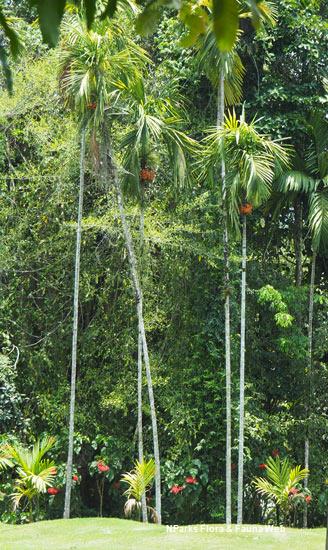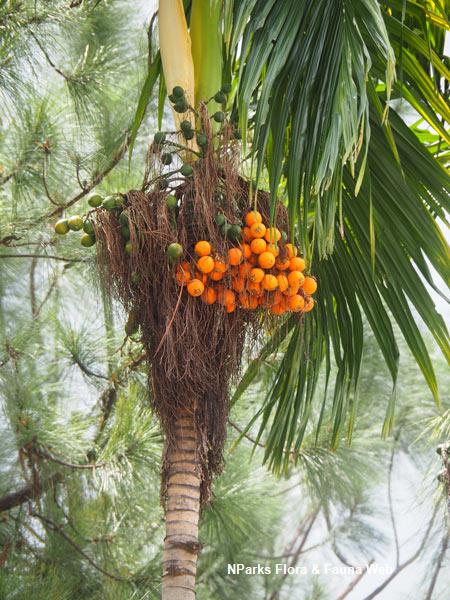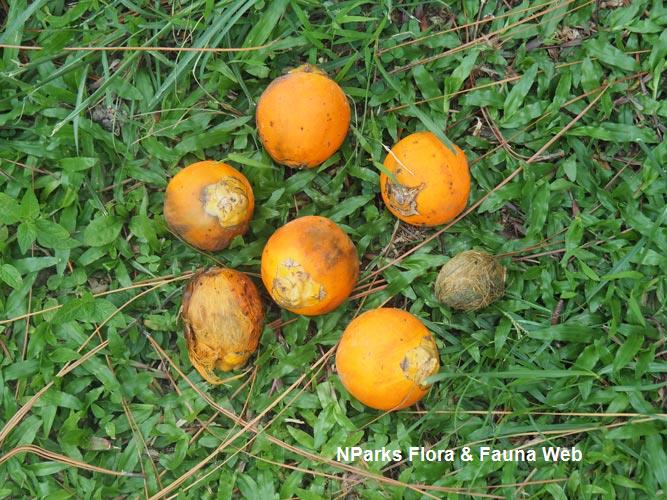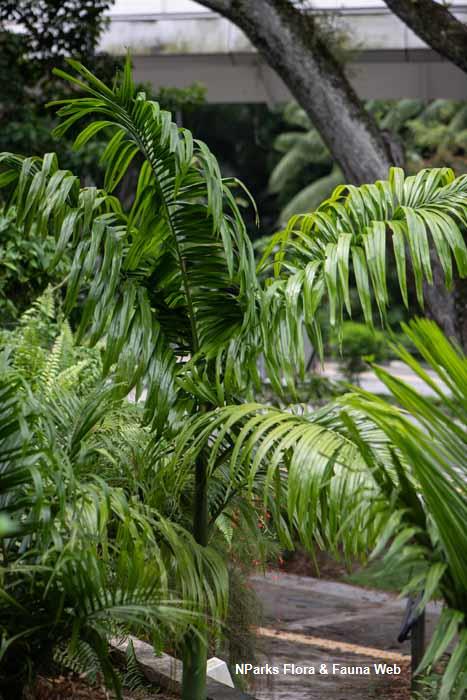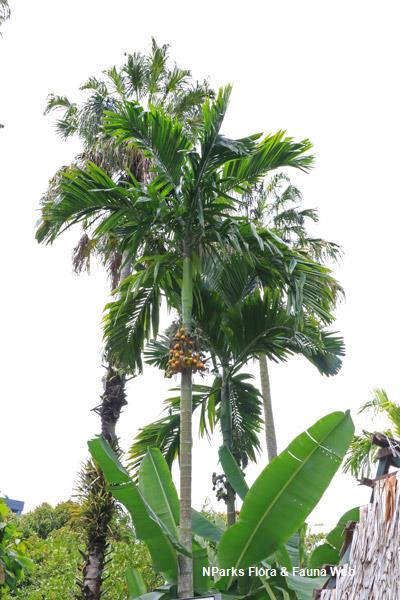
Back
Areca catechu L.
| Family Name: | Arecaceae (Palmae) |
| Synonyms: | Areca faufel Gaertn., Areca hortensis Lour. |
| Common Name: | Betel Nut Palm, Pinang, Betel Palm, Areca, Areca-nut, Pinang Siri, 槟榔 |
Areca catechu, also known as Betel Nut Palm, is a solitary-growing palm with feather-like leaves and a green crownshaft. In its natural habitat, it can grow up to 30 meters tall. The palm is often cultivated for its seed (nut) that is often chewed with the betel (Piper betle) and edible lime.
Name
Classifications and Characteristics
| Plant Division | Angiosperms (Flowering Seed Plants) (Monocotyledon) |
|---|---|
| Plant Growth Form | Palm (Solitary Habit) |
| Lifespan (in Singapore) | Perennial |
| Mode of Nutrition | Autotrophic |
| Maximum Height | 20 m |
| Maximum Plant Spread / Crown Width | 3 m |
Biogeography
| Native Habitat | Terrestrial |
|---|---|
| Preferred Climate Zone | Tropical |
| Local Conservation Status | Non-native (Horticultural / Cultivated Only) |
Description and Ethnobotany
| Growth Form | It is a slender, upright, solitary-growing palm, growing up to 10 - 30 m tall. |
|---|---|
| Trunk | The trunk is solitary, slender, prominently marked with annulated frond scars, reaching 40 cm in diameter. |
| Foliage | The fronds are arching, semi-erect, and even-pinnately compound, up to 1.5 - 2 m long, with 30-50 leaflets, curving inward with age. A few of the lowest leaflets are often hanging. |
| Crown Shaft | The crown shaft is green. |
| Flowers | The inflorescence is a multiple-branching panicle growing up to 0.7 m long, with creamy-white, fragrant flowers. It is infrafoliar, emerging below the fronds and crown shaft, and subtended by a spathe or peduncular bract. The female flowers are found towards the base of the branches, while numerous male flowers extend towards the tips. |
| Fruit | The fruits are ovoid fibrous drupes up to 5 - 10 cm long x 3 - 5 cm wide. They ripen from yellow to orange or red. Each fruit consists of 1 ovoid or globose, brown seed usually flattened on one end. |
| Habitat | Native habitat unknown; it is widely cultivated throughout tropical Asia and might probably originate from Central Malesia or the Philippines |
| Cultivation | It grows well in deep, well-drained soils that are slightly acidic to neutral and bright direct sunlight. Young plants can tolerate low to medium light but have a low tolerance for salt and wind (the crown becomes tattered after strong gusts). It can be propagated by seeds. |
| Etymology | The genus epithet Areca is derived from a vernacular name by the locals of the Malabar coast of India for a species of this particular genus. The specific epithet catechu is from a Malayan name caccu, which is used for the palm. The common name 'Betel Nut Palm' is derived from the use of the palm nut, where the leaves of Betel (Piper betle) are often chewed together with the palm's nut and edible lime. Thus by association, it has been conveniently known as 'betel nut'. |
| Ethnobotanical Uses | Edible Plant Parts : Edible Seeds Others: The seed (nut) is chewed by the natives, and stains the lips and teeth red, with the excrement being hot and acrid. Seed (nut) is aromatic and astringent, and can be addictive. It is used against anaemia, fits, leucoderma, leprosy, and obesity, and is also a purgative and an ointment for nasal ulcers. In India, the nut has been used to treat tapeworms. Traditionally, flowers are used in medicine as charms to heal the sick in Borneo. Chewing on the seeds (nuts) produces euphoria, heightened alertness, sweating, salivation, and an increased capacity to work, and alkaloid arecoline, which is found in the nut, accounts for these effects. However, studies have shown that there is an association with oral submucous fibrosis (OSF), pre-cancerous oral lesions and squamous cell carcinoma. Acute effects of chewing betel nuts include asthma, hypotension and tachycardia. |
Landscaping Features
| Desirable Plant Features | Ornamental Form |
|---|---|
| Landscape Uses | Suitable for Roadsides |
| Thematic Landscaping | Economic Garden |
Plant Care and Propagation
| Light Preference | Full Sun |
|---|---|
| Water Preference | Moderate Water |
| Plant Growth Rate | Fast to Moderate |
| Rootzone Tolerance | Well-Drained Soils, Fertile Loamy Soils |
| Propagation Method | Seed |
Foliar
| Foliage Retention | Evergreen |
|---|---|
| Mature Foliage Colour(s) | Green |
| Mature Foliage Texture(s) | Glossy / Shiny, Smooth |
| Foliar Type | Compound (Even-Pinnate) |
| Foliar Arrangement Along Stem | Spiral |
| Foliar Attachment to Stem | Petiolate |
| Foliar Shape(s) | Palm Fronds (Pinnate / Feather) |
| Foliar Venation | Parallel |
| Leaf Area Index (LAI) for Green Plot Ratio | 2.5 (Palm - Solitary) |
Non - Foliar and Storage
| Trunk Type (Palm) | Aboveground, Solitary Habit |
|---|---|
| Root Type | Underground (Fibrous Root) |
Floral (Angiosperm)
| Flower & Plant Sexuality | Unisexual Flowers , Monoecious |
| Flower Colour(s) | Cream / Off-White |
|---|
| Flower Grouping | Cluster / Inflorescence |
| Flower Location | Axillary |
| Flower Symmetry | Radial |
| Inflorescence Type | Panicle |
| Ovary Position | Superior / Hypogynous |
| Flowering Habit | Polycarpic |
Fruit, Seed and Spore
| Mature Fruit Colour(s) | Red |
|---|---|
| Mature Fruit Texture(s) | Smooth |
| Fruit Classification | Simple Fruit |
| Fruit Type | |
| Mature Seed Colour(s) | Brown |
| Seed Quantity Per Fruit | Few (1-5) |
References
| References | Jones, D.L. (1995). Palms throughout the World. Smithsonian Institution Press, Washington DC: 129. |
|---|
Image Repository
Others
| Master ID | 1294 |
|---|---|
| Species ID | 2587 |
| Flora Disclaimer | The information in this website has been compiled from reliable sources, such as reference works on medicinal plants. It is not a substitute for medical advice or treatment and NParks does not purport to provide any medical advice. Readers should always consult his/her physician before using or consuming a plant for medicinal purposes. |

